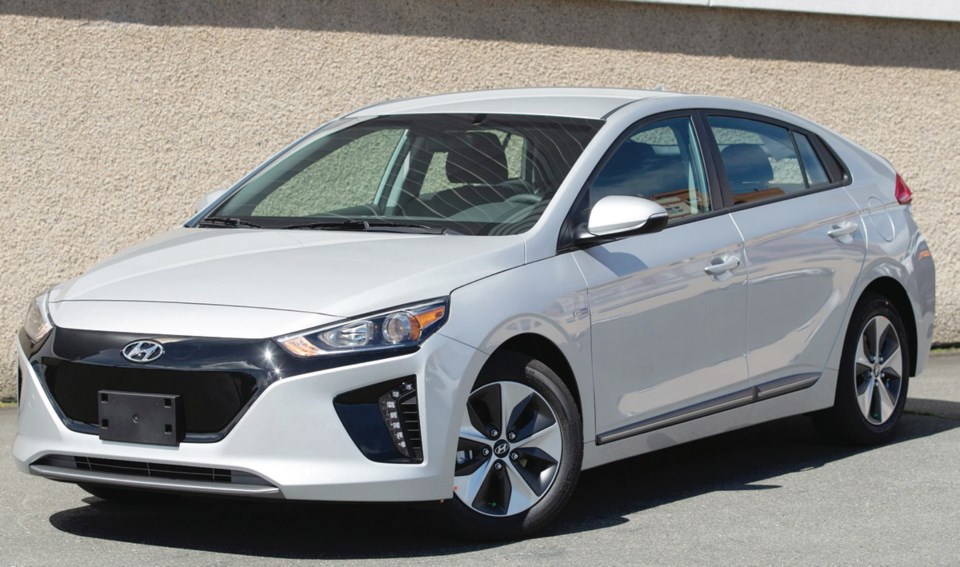On the surface, it would appear that Hyundai just launched a new vehicle ÔÇö the 2017 Ioniq. But in reality, the Korean manufacturer has introduced not just one, but three different electrified cars.
The launch has sent ripples throughout the industry.
The Ioniq is not HyundaiÔÇÖs first foray into using electricity to help power their vehicles. The Sonata Hybrid landed on our shores in 2011.
But this time, consumers can choose between three powerplants ÔÇö a battery-electric vehicle (BEV), a hybrid electric vehicle (HEV) and a plug-in hybrid electric vehicle (PHEV).
At launch, the Ioniq is available in BEV and HEV formats, with the PHEV available in a few months.
HyundaiÔÇÖs move is unprecedented in the industry. Even Toyota, which introduced the hybrid electric Prius back in 1997, still only offers the one format. General Motors offers two: the Volt, an extended range electric vehicle, and the new Bolt, a battery-electric vehicle.
To introduce three ÔÇö in one model ÔÇö is a barometer of where Hyundai expects the industry is going. Their thinking, perhaps, is that because there are positive attributes of each technology, build them all and let the consumer decide.
As a side note, Hyundai has also invested in hydrogen as a fuel as well, with a Tucson Fuel Cell vehicle in the wings (I test drove an example in 2015).
This week, I drove a Ioniq BEV, which is available in three trims ÔÇö SE, SE with a Cold Winter Package and Limited.
The hybrid Ioniq starts at $24,299, the pure electric at $35,649. The $11,350 difference is softened somewhat by British ColumbiaÔÇÖs incentive to get us all in clean energy vehicles. If you are still driving an old gas hog, you can scrap it and save up to $11,000 combined, which effectively makes the EV cost as much as the hybrid. For more information, go to cevforbc.ca.
The hybrid has a 1.6-litre four-cylinder gas engine paired with a 32 kW electric motor and a six-speed dual-clutch automatic transmission. The EV comes with one 88 kW motor and a single-speed transmission.
In the EV, the gas tank is replaced by a 28 kW battery, with a claimed 200-kilometre range on a single charge. That range is the kicker, as ÔÇ£range anxietyÔÇØ is a major hurdle for new adoptees.
Among EVs, the Nissan Leaf can get up to 172 km, the Ford Focus EV 122 km. The Chevrolet Bolt, also recently introduced, is the segment leader, with a 320-km range. (Due to its $90,000-plus price tag, I have left out the Tesla X, with its 413-km range, from this comparison.)
Size-wise, the Ioniq is closer to the Leaf than the Bolt, which is more than 300 millimetres shorter in length. Despite being within millimetres of the Leaf, the Ioniq is lighter, tipping the scales at 1,420 kilograms (which is more than 200 kilograms lighter than the smaller Bolt).
Power-wise, the Ioniq is in the middle between its two competitors, with the 88-kW electric motor, good for 118 horsepower and 218 foot-pounds of torque, more powerful than the Leaf but less than the Bolt. It feels a lot more powerful than the numbers suggest, with a chirp of the wheels possible when the accelerator (remember there is no gas pedal anymore) is depressed to the floor.
There is ample juice on the highway, with cruising at 100 km/h a relaxing experience.
What is unique with the Ioniq are two paddles on the steering wheel. On conventional vehicles, these are used to shift up and down on the transmission. On the Ioniq, they are used to adjust the level of engine recharging. The three levels act like an invisible brake, making the forward motion a source of kinetic energy. Other EVs have a button or gear setting that is similar, but the Ioniq has taken it to the next level.
Using the paddles, a driver can slow the car down to a stop. If travelling down a hill, the Ioniq can actually gain a few kilometres of range using this technique.
But how will drivers behind know you are slowing if your brake lights never go on?
The interior of the Ioniq is much like any contemporary car, with a well-laid out dash and good attention to detail. The only odd feature is the transmission selector, which has four buttons for Drive, Park, Neutral and Reverse.
There are three ways to charge the Ioniq: Using a standard 120v household outlet (24 hours to full charge), a Level 2 charger installed at home or available at various public venues (4.5 hours) or a Level 3 charger, which can charge the car in 35 minutes.
The inclusion of the latter charger is also a sea change in EVs. If the number of Level 3 chargers increase, it would mean that travel between cities ÔÇö and across the country ÔÇö would finally be possible. Not many people want to spend four and a half hours waiting for their car to charge to continue their journey.
Hats off to Hyundai on their achievements. The Ioniq is a shot over the bow for other manufacturers as to the future electrification of their fleets. We have been talking about green cars for years. Hyundai has now thrown down the gauntlet with three champions. Who will take them on?
╠²
THE SPEC SHEET
Type: Compact Battery Electric Vehicle, front engine, front-wheel-drive
Engine: 88 kW electric motor
Transmission: Single speed
Dimensions (mm): Length, 4,470; width, 1,821; height, 1,450; wheelbase, 2,700
Curb weight (kg): 1,370
Price (base/as tested): $35,649/$37,454 (includes $1,705 freight and PDI and $100 AC tax)
Options: Nil
Tires: 195/65 R15 on alloy wheels
Fuel type: Electricity
Fuel economy (Litres equivalent/100km): 1.6 city/ 1.9 highway
Warranty: Five years/100,000 km new car
